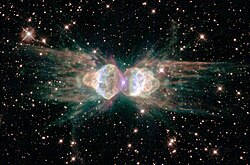
A planetary nebula is a type of emission nebula consisting of an expanding, glowing shell of ionized gas ejected from red giant stars late in their lives.

The Helix Nebula is a planetary nebula (PN) located in the constellation Aquarius. Discovered by Karl Ludwig Harding, most likely before 1824, this object is one of the closest of all the bright planetary nebulae to Earth. The distance, measured by the Gaia mission, is 655±13 light-years. It is similar in appearance to the Cat's Eye Nebula and the Ring Nebula, whose size, age, and physical characteristics are similar to the Dumbbell Nebula, varying only in its relative proximity and the appearance from the equatorial viewing angle. The Helix Nebula has sometimes been referred to as the "Eye of God" in pop culture, as well as the "Eye of Sauron".

The Cat's Eye Nebula is a planetary nebula in the northern constellation of Draco, discovered by William Herschel on February 15, 1786. It was the first planetary nebula whose spectrum was investigated by the English amateur astronomer William Huggins, demonstrating that planetary nebulae were gaseous and not stellar in nature. Structurally, the object has had high-resolution images by the Hubble Space Telescope revealing knots, jets, bubbles and complex arcs, being illuminated by the central hot planetary nebula nucleus (PNN). It is a well-studied object that has been observed from radio to X-ray wavelengths.
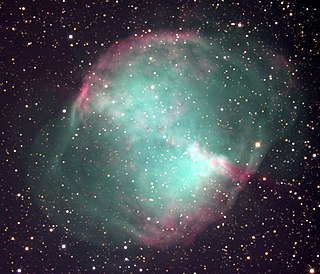
The Dumbbell Nebula is a planetary nebula in the constellation Vulpecula, at a distance of about 1360 light-years. It was the first such nebula to be discovered, by Charles Messier in 1764. At its brightness of visual magnitude 7.5 and diameter of about 8 arcminutes, it is easily visible in binoculars and is a popular observing target in amateur telescopes.

The Eskimo Nebula, also known as the Clown-faced Nebula, Lion Nebula, or Caldwell 39, is a bipolar double-shell planetary nebula (PN). It was discovered by astronomer William Herschel in 1787. The formation resembles a person's head surrounded by a parka hood. It is surrounded by gas that composed the outer layers of a Sun-like star. The visible inner filaments are ejected by a strong wind of particles from the central star. The outer disk contains unusual, light-year-long filaments.

The Stingray Nebula is the youngest-known planetary nebula, having appeared in the 1980s. The nebula is located in the direction of the southern constellation Ara, and is located 18,000 light-years away. Although it is some 130 times the size of the Solar System, the Stingray Nebula is only about one tenth the size of most other known planetary nebulae. The central star of the nebula is the fast-evolving star SAO 244567. Until the early 1970s, it was observed on Earth as a preplanetary nebula in which the gas had not yet become hot and ionized.

Minkowski 2-9, abbreviated M2-9 is a planetary nebula that was discovered by Rudolph Minkowski in 1947. It is located about 2,100 light-years away from Earth in the direction of the constellation Ophiuchus. This bipolar nebula takes the peculiar form of twin lobes of material that emanate from a central star. Astronomers have dubbed this object as the Twin Jet Nebula because of the jets believed to cause the shape of the lobes. Its form also resembles the wings of a butterfly. The nebula was imaged by the Hubble Space Telescope in the 1990s.

The Little Dumbbell Nebula, also known as Messier 76, NGC 650/651, the Barbell Nebula, or the Cork Nebula, is a planetary nebula in the northern constellation of Perseus. It was discovered by Pierre Méchain in 1780 and included in Charles Messier's catalog of comet-like objects as number 76. It was first classified as a planetary nebula in 1918 by the astronomer Heber Doust Curtis. However, others might have previously recognized it as a planetary nebula; for example, William Huggins found its spectrum indicated it was a nebula ; and Isaac Roberts in 1891 suggested that M76 might be similar to the Ring Nebula (M57), as seen instead from the side view.

A protoplanetary nebula or preplanetary nebula is an astronomical object which is at the short-lived episode during a star's rapid evolution between the late asymptotic giant branch (LAGB)[a] phase and the subsequent planetary nebula (PN) phase. A PPN emits strongly in infrared radiation, and is a kind of reflection nebula. It is the second-from-the-last high-luminosity evolution phase in the life cycle of intermediate-mass stars.
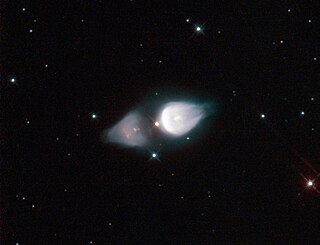
M1-92, also known as Minkowski’s Footprint or the Footprint Nebula, is a bipolar protoplanetary nebula in the constellation of Cygnus. It is a type of reflection nebula, visible only by light reflected from the central star. The central star is not yet a white dwarf but is quickly becoming one. In a few thousand years the star will be hot enough to emit vast quantities of ultraviolet radiation that will ionize the nebula surrounding it, making it a fully fledged planetary nebula.

The Red Rectangle Nebula, so called because of its red color and unique rectangular shape, is a protoplanetary nebula in the Monoceros constellation. Also known as HD 44179, the nebula was discovered in 1973 during a rocket flight associated with the AFCRL Infrared Sky Survey called Hi Star. The binary system at the center of the nebula was first discovered by Robert Grant Aitken in 1915.

NGC 6302 is a bipolar planetary nebula in the constellation Scorpius. The structure in the nebula is among the most complex ever observed in planetary nebulae. The spectrum of NGC 6302 shows that its central star is one of the hottest stars known, with a surface temperature in excess of 250,000 degrees Celsius, implying that the star from which it formed must have been very large.

NGC 6751, also known as the Glowing Eye Nebula, is a planetary nebula in the constellation Aquila. It is estimated to be about 6,500 light-years away.

A bipolar outflow comprises two continuous flows of gas from the poles of a star. Bipolar outflows may be associated with protostars, or with evolved post-AGB stars.

Mz 1 , is a bipolar planetary nebula (PN) in the constellation Norma.
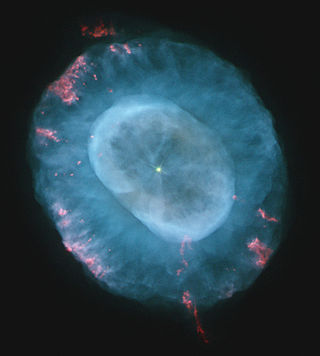
NGC 7662 is a planetary nebula located in the northern constellation Andromeda. It is known as the Blue Snowball Nebula, Snowball Nebula, and Caldwell 22. This nebula was discovered October 6, 1784 by the German-born English astronomer William Herschel. In the New General Catalogue it is described as a "magnificent planetary or annular nebula, very bright, pretty small in angular size, round, blue, variable nucleus". The object has an apparent visual magnitude of 8.3 and spans an angular size of 32″ × 28″. Parallax measurements give a distance estimate of 5,730 ± 340 ly (1,757 ± 103 pc).

NGC 6905, also known as the Blue Flash Nebula, is a planetary nebula in the constellation Delphinus. It was discovered by William Herschel in 1784. The central star is 14.0 mag. The distance of the nebula, as with most planetary nebulae, is not well determined and estimates range between 1.7 and 2.6 kpc.
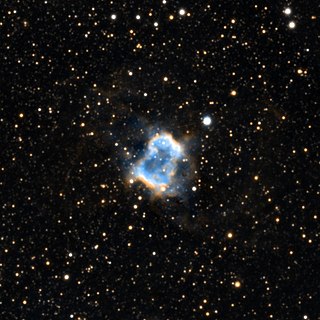
NGC 6445, also known as the Little Gem Nebula or Box Nebula, is a planetary nebula in the constellation Sagittarius. It was discovered by William Herschel on May 28, 1786. The distance of NGC 6445 is estimated to be slightly more than 1,000 parsecs based on the parallax measured by Gaia, which was measured at 0.9740±0.3151 mas.
LoTr 5 is a large, faint planetary nebula in the constellation of Coma Berenices. In 2018, its parallax was measured by Gaia, giving a distance of about 1,650 light-years.

KjPn 8 is a bipolar planetary nebula which was discovered by M.A. Kazaryan and Eh. S. Parsamyan in 1971 and independently by Luboš Kohoutek in 1972.
